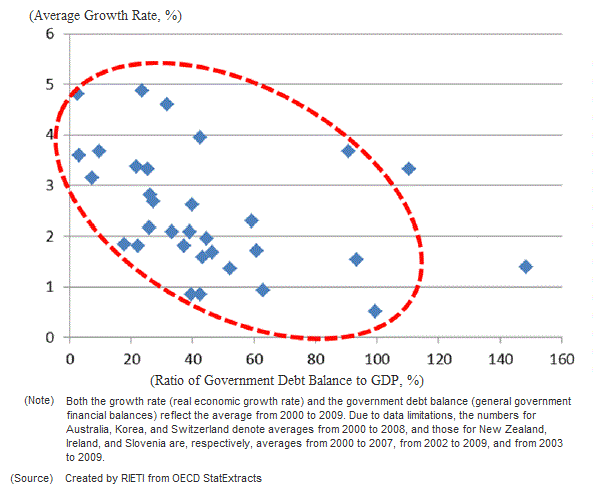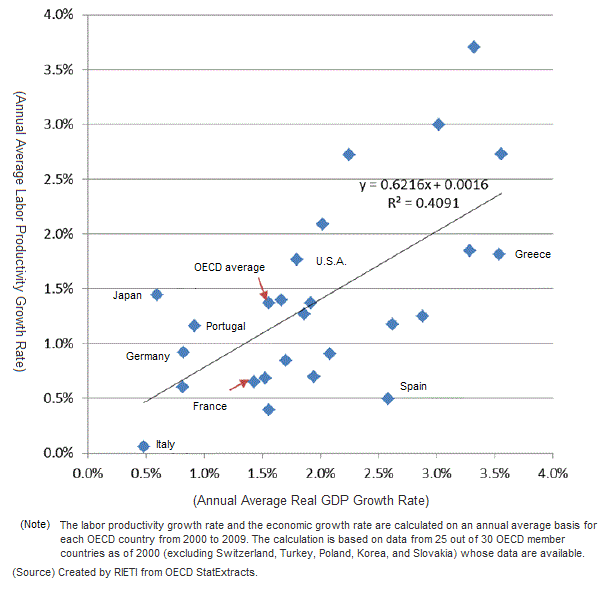As the U.S. debt limit bill passed, the U.S. default was avoided for the time being. Due to the future uncertainty, however, of the U.S. economy and the downgrading of the long-term U.S. Treasury Bond by S&P from AAA to AA+ for the first time in history on account of an insufficient debt reduction plan by the U.S. government, the world market has been significantly disturbed with declines in stock prices and dollars.
The situation in Europe has also been a major cause for the disturbance of the market. In Europe, the second Greek bailout was agreed in July in conjunction with the Greek sovereign debt problem to avert the Greek default for the time being. As the bailout, however, has remained no more than a stopgap measure, spreading sovereign debt uncertainty to Italy and Spain, it is questioned to what extent Germany--which is to play the central role--is prepared to provide the bailouts.
This column points out the possibility of a decline in economic growth rate caused by an increase in government debt and attempts to describe responses that should be taken.
Economic growth rate in inverse proportion to the government debt balance
There are many economic problems caused by an increase in government debt, including a rise in market interest rates, constraints to flexible fiscal policy, crowding out, contraction in consumption in view of a future increase in the debt repayment burden, and aggravated inter-generational unfairness. It should also be noted that it brings about an overall decline in the economic growth rate.
Reinhart & Rogoff (2010) (Note 1), who examined the relation between the ratio of the government debt balance to GDP and the economic growth rate of 20 advanced countries from 1946 to 2009, showed that, if the government debt/GDP ratio exceeded 90%, the median economic growth rate was 1% lower, with the average economic growth rated being even lower (approximately 4% less for the data used), than if the ratio was 90% or less. Indeed, if the relation between the ratio of the yearly average government debt balance to GDP and the economic growth rate of OECD countries is examined over the past 10 years, an inverse correlation is evident between the debt ratio and the economic growth rate: the higher the former was, the lower the latter tended to be (Figure 1).

Given various problems brought about by an increase in a government debt balance, an effort to reduce the fiscal imbalance appropriately (preventing its further increase, at least) is indispensable, while paying attention to the economic trend. Such an effort may give a positive effect on the economic growth rate in the long term by realizing the potential of the private sector. A reduction in the fiscal deficit, however, may give a negative effect on the economy in the short term through measures to reduce expenditures, increase taxes, etc. In fact, fiscal constraints have caused uncertainty in the future economic outlook in the United States. Now in Greece, although bold fiscal austerity measures are being implemented, their full implementation is facing difficulties due to economic stagnation, a rising unemployment rate, and, above all, increased dissatisfaction by people.
The only way to overcome the problem of a downward pressure on the economy caused by redressing the fiscal imbalance is to let private companies lead economic growth by increasing their productivity. The average annual economic growth rate and the labor productivity growth rate of OECD countries over the past decade is evidence for a relation that countries with high economic growth rates generally have a high rate of labor productivity growth (Figure 2). It is true that the labor productivity growth rate has a high correlation with the economic growth rate, as the former is at the mercy of the latter. The correlation between the labor productivity growth rate and the economic growth rate of the United States, however, is higher than OECD countries' average, whereas that of Greece is lower.

Crossroad for Japan suggested by the Western sovereign debt crisis
In light of the relation between the economic growth rate and productivity, Greece is going to face considerable difficulties in financial and economic reconstruction that may require ongoing resoluteness. The difficulties lie not only in the reduction of ever-increasing government debt but also in a stringent social security reform indispensable for fiscal consolidation. Needless to say, it is important for a successful financial reconstruction how to realize an increase in productivity in the corporate sector under the stagnant economy.
On the other hand, the United States does not seem to be in a situation as severe as Greece's. For, in addition to the relatively high growth rate of its corporate productivity, the country's annual rate of population increase, including the effect of immigration, is about 1%, which is bolstering its economic growth. It is rather a serious problem for the United States how to improve its level of social security, which is not as solid as that of advanced European countries, while attempting financial consolidation including social security reform.
While Western countries are in differing situations, Japan is in a situation similar to that of Greece. Figure 1 suggests that its outstanding ratio of government debt balance to GDP can significantly limit its economic growth, and low fertility and an aging population will further curtail its potential for growth in the future. While there is a limit to increasing the government debt balance/GDP ratio, financial reconstruction will be more challenging as long as things remain as they are. What is particular serious is that it will be unavoidable to perform a major reform of social security, which has been a primary cause for expansion of financial deficits as has been observed in Western countries. A deterioration of the social security level must be avoided in Japan, whose degree of income redistribution is below the OECD countries' average.
Fortunately, as Figure 2 shows, Japan has increased exports to support its economic growth rate by maintaining international competitiveness through an improvement in corporate productivity. The recent sovereign debt crisis in Western countries arguably suggests once again a possibility that Japan, which has the outstanding ratio of government debt balance to GDP, may eventually fall into the same situation and, at the same time, the fact that Japan is at an important juncture whether it can step into the reduction of the government debt balance/GDP ratio before the vitality in its corporate sector is lost.

